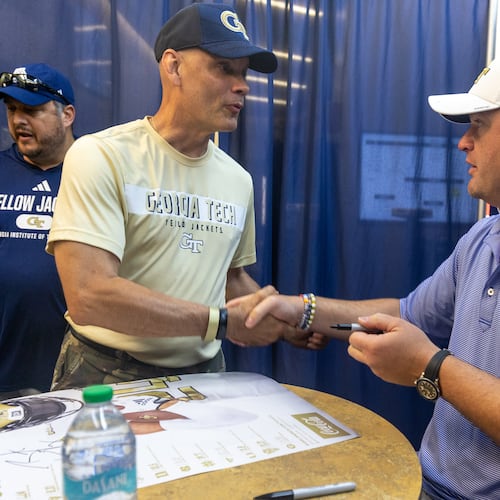In the fall of 1892, Georgia Tech was scarcely recognizable to the monolith that it has become in the decades since. Then known as the Georgia School of Technology, the institute had opened its doors four years earlier, surrounded by an expanse of green on the edge of Atlanta. It was a school with one major (mechanical engineering), two buildings (one of which was the structure that would become known as Tech Tower), nine faculty members and 138 students.
The school wouldn’t admit women for another 60 years (1952) and African American students for another nine years after that (1961).
But the Tech of then and now were the same in at least one aspect – both had football teams.
“The Techs are rapidly becoming a well-trained set of players and are practicing every afternoon,” the Atlanta Constitution reported in October 1892, the story placed near an advertisement urging readers to “Buy your winter coal now.”
» RELATED: Georgia Tech-Virginia: TV, online, radio information
» MORE: How to watch all 49 FBS games
College football’s first-ever game – Rutgers vs. Princeton – was played 150 years ago Wednesday. As the game’s chieftains commemorate that milestone throughout this season – players are wearing a “150” patch on the shoulders of their jerseys – it would be fitting to recall Tech’s own humble beginnings in football. In a coincidence, the Yellow Jackets lined up for their first-ever game 127 years ago Tuesday, on Nov. 5, 1892.
Originated in the Northeast, football reached the South two decades later. Tech’s team was founded by professor Ernest E. West, who had played while a cadet at the U.S. Naval Academy. Coach and captain, West played left halfback for the Techs, or Tecks, as students were known, at a time when eligibility rules were a little looser than today. (West would go on to fight in the Spanish-American War with the Marines, achieving the rank of captain.) The Constitution story boasted that the center-rush (now known as the center) weighed in at a hefty 165 pounds.
The game bore some similarity to the version played now. There were four downs to gain five yards, a line of scrimmage and field dimensions of 120 yards by 53 1/3 yards.
Touchdowns were worth five points, same as field goals, with conversion kicks worth one. A big difference was that the forward pass was not legal and there was also no rule requiring seven players to be on the line of scrimmage.
“You’d have four or five lead blockers (in the backfield), and you only needed five yards to gain a first down at that time, so you’d kind of trample over the poor soul on the line that you were attacking,” said Kent Stephens, historian at the College Football Hall of Fame. “I guess the good news is that, since everybody was smaller, you didn’t have 300-pounders trampling on you.”
On Nov. 5, 1892 (a Saturday), the two teams met at Macon’s Central City Park, a space still in existence. The Atlanta Constitution reported that “a large contingent of backers that came down from Atlanta with the ‘Techs’” helped fill the bleachers.
“The black and yellow streamers worn by Mercer men and the white and yellow of the Technological school added to the carnival gayety,” the Constitution wrote.
Alas, Mercer, playing its third game of the calendar year (having lost to Georgia and the Savannah Catholic Library Association in January and March, respectively), brought an end to Tech’s “gayety,” winning 12-6 and presumably placing coach West on the hot seat.
The manner of defeat might sound familiar to fans of the latter-day Techs.
The Journal and Constitution reports observed that Tech players “evidently had a better idea of the science of the game than the home team” and that “The ‘Tecks’ eleven were much cleverer players.” However, the articles also observed that “the superior weight of the Macon men proved too much for the ‘Tecks’” and that “they used their superior weight every time to advantage.”
Wrote the Constitution, “The Technological school must put more weight into the rush line to be able to cope with Auburn on Thanksgiving Day, though they play a fast and plucky game.”
Tech finished its inaugural season 0-3, losing to Vanderbilt at Piedmont Park and Auburn 26-0 at Brisbane Park, a ball ground in southwest Atlanta no longer in existence. Victory would follow in 1893 at the hands of Georgia, in Athens, no less.
Some 127 years later, Captain West’s successors continue their search for weightier rush lines.
About the Author
Keep Reading
The Latest
Featured



